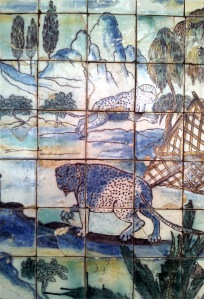 The cathedral of Porto is near the Sao Bento station. As we walked up to it, the bright sun was behind the twin towers of the cathedral, and in our eyes. The Family said that it does not look very impressive from outside. We walked into the interior gloom. The cathedral did not look very impressive inside either. A narrow but high nave was topped with the barrel vaulting typical of Romanesque churches. The baroque porch from which we had entered was clearly added on much after 1120, when this part of the cathedral was completed. The Family took a closer look at the chapels and the decoration while I sat on a bench and nursed a bad knee.
The cathedral of Porto is near the Sao Bento station. As we walked up to it, the bright sun was behind the twin towers of the cathedral, and in our eyes. The Family said that it does not look very impressive from outside. We walked into the interior gloom. The cathedral did not look very impressive inside either. A narrow but high nave was topped with the barrel vaulting typical of Romanesque churches. The baroque porch from which we had entered was clearly added on much after 1120, when this part of the cathedral was completed. The Family took a closer look at the chapels and the decoration while I sat on a bench and nursed a bad knee.
The entrance to the place of worship is seldom ticketed, and this was no exception. However, you had to pay to enter the cloister attached to the cathedral. We duly paid up to enter the much more interesting Gothic cloister built during the 14th and 15th centuries (see the featured image). The azulejo panels at this level were designed in the early 18th century by Valentim de Almeida. The tiled panels on the upper level, which you can see bits of in the featured photo, were designed by Antonio Vidal around the same time.
 We walked around the quadrangle. One of the doors leads to a renaissance staircase designed by the 18th century Italian architect Nicolau Nasoni who built many landmarks around the city. We peered at this, then walked around to the treasury inside the chapterhouse. We walked in a daze past shiny pieces meant to impress and suddenly spotted the odd decoration shown alongside. Could it really be a piece of the skin of St. Francis Xavier? We clicked a photo for our friends from Goa, and moved on. Baroque paintings decorate the roof of the chapterhouse. We admired them and moved up to the terrace.
We walked around the quadrangle. One of the doors leads to a renaissance staircase designed by the 18th century Italian architect Nicolau Nasoni who built many landmarks around the city. We peered at this, then walked around to the treasury inside the chapterhouse. We walked in a daze past shiny pieces meant to impress and suddenly spotted the odd decoration shown alongside. Could it really be a piece of the skin of St. Francis Xavier? We clicked a photo for our friends from Goa, and moved on. Baroque paintings decorate the roof of the chapterhouse. We admired them and moved up to the terrace.
One can take a closer look at the tiled murals here. These are genuinely beautiful, and totally Portuguese. We looked up at the steeple with a statue of a saint brandishing a cross from his niche. A sea gull sat on the large cross atop everything. Weeds grew out of the mortar. We’d noticed before that the once powerful church has entered a little bit of a backwater in this century. We went down by Nasoni’s stairs. The broad steps, evenly spaced, are very good for the knees. If you ever wonder why an architect has to design stairs, try descending a long flight of stairs made by amateurs. Your knees will tell you how bad they are.
There was a guide standing in the cloister. We asked her where Nasoni was buried. She did not know. As we exited we asked the lady who sold us the tickets where we could see Nasoni’s grave. She excitedly told us that no one knows. According to her he was buried somewhere in the cathedral, but the records are lost. Later we googled this and found that he is buried in one of the famous churches he built: the church of Sao Pedro dos Clerigos.
















